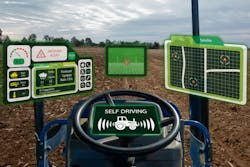The Changing Landscape of Communication Protocols for Fluid Power Systems
In August 2024, the National Fluid Power Association (NFPA) released its Communication & Data Protocols for Mobile Equipment white paper. The goal of the document is to help educate members of the fluid power industry on commonly used communications and data protocols in mobile equipment, one of the largest customer markets for the sector.
Major industry trends such as connectivity, electrification, and automation are bringing about changes to fluid power system designs, including the communication networks and protocols with which they need to interact.
During the NFPA’s Industry & Economic Outlook Conference (IEOC) held in August 2024, a panel discussion was held to discuss information included in the white paper with some of the association’s members who helped develop it.
At that time, Eric Lanke, President and CEO of NFPA, said many fluid power system integrators and manufacturers struggle to make sure their componentry and systems integrate well with these evolving systems at the machine level and understanding that data protocol environment is really key.
As such, the association felt it would be valuable to create a resource which could help improve their understanding.
NFPA’s Mobile Technology Task Force — comprised of members across the supply chain who work in the mobile equipment space — came together to share information and industry perspectives to create the white paper which provides definitions of terms as well as reviews of current and future technology considerations.
Download the Communication & Data Protocols for Mobile Equipment white paper from NFPA’s website.
NFPA Technology Task Forces Aim to Identify Technology Needs in Fluid Power
The NFPA’s Communication & Data Protocols for Mobile Equipment white paper is one of several projects the association is undertaking to help members of the fluid power industry better understand the trends shaping the future of hydraulic and pneumatic designs.
Many of these projects are guided by the 2023 NFPA Technology Roadmap – a document designed to provide an R&D roadmap for the fluid power industry by overviewing trends impacting the industry and potential development areas to ensure hydraulics and pneumatics remain a motion control technology of choice.
After the publishing of this document, NFPA established two Technology Task Forces, one focused on mobile applications and the other on industrial applications. These task forces are working to identify technology areas in which more information may be needed and provide educational tools for the fluid power sector such as the communication protocols white paper.
Why the Fluid Power Industry Needs to Look Beyond CANbus
Networks and communication protocols are terms used for how electronic devices on a mobile machine “talk” to one another. Per the NFPA white paper, they can be wired or wireless and communicate using various protocols (i.e., rules allowing devices to transmit information) based on application requirements.
There are currently several types of networks and protocols used in mobile equipment applications, but the ones primarily utilized are the CAN network and SAE J1939 protocol. Use of CAN-J1939, as it is referred to, became widespread due to its adoption by diesel engine manufacturers for their electronic control units (ECU) in the late 1980s.
As the ECU was the primary electronic component in most vehicles for many years, OEMs chose to adopt CAN-J1939 for other components, including hydraulics and pneumatics, as well to have a cohesive in-vehicle communication system. This helped to reduce wiring and development costs.
However, as technologies have evolved so too have the networks and protocols available to the mobile market. The automotive industry, which first developed the CANbus networks now common in so many vehicles and machines, has moved on to use of faster and less expensive options according to the NFPA white paper. Technology and trends in this industry usually find their way into the mobile equipment space as well.
Mike Terzo, CEO and Founder of Xirro — a developer of hybrid and electric vehicle power systems — said during the IEOC panel discussion that industry conversations about moving past J1939 are due to what is flowing over from the automotive sector, a lot of which is around electrification. Digitization is also a factor, but he said most of the new protocols now coming into play have primarily been driven by increased development of electric vehicles.
He noted that automation can be lumped in with this too, and that really all of it has to do with the digital technologies which are moving onto vehicles. This is bringing many pain points for manufacturers in regard to determining how best to integrate the technologies while also reducing the cost of protocols and ensuring fast enough bandwidths for the solutions coming into the market.
Other industry trends driving a re-evaluation of networks and protocols include:
- functional safety
- cybersecurity
- increased connectivity.
With these there comes a need for safe and secure communications, some of which is either not possible or more difficult to achieve with current protocol technologies.
The Communication Protocols to Watch for in the Coming Years
A key part of the NFPA white paper is its outlining of 16 communication protocols that are currently being used or up and coming for mobile equipment applications. Charts in the document provide technical data for each, their pros and cons, as well as examples of how they are used in some mobile machines.
Terzo said these charts were included to help provide a quick and easy reference to help the fluid power industry understand the various protocols in the market and what may or may not work for a given application.
For his own company’s products, Terzo said LIN (local interconnect network) is utilized because it is the least expensive protocol. This is also why it has become more commonly used in the automotive sector. He said LIN is incorporated into Xirro’s products because it is more cost effective than other protocols when also integrating several sensors.
He said going with LIN can help reduce costs associated with hardware wiring and in terms of implementing it at the board or software level because it is easier to use. While it has a limited bandwidth, it is a good option for simple, low-speed functions.
Visit our State of the Industry page for more economic and technology market trend information related to the hydraulic, pneumatic and electromechanical motion control industries.
Cost is an important factor for many, and a driver for the increased presence of various communication protocols in the market. Terzo noted implementing a protocol onto electronic components can be cumbersome and expensive. But there is a proliferation of cost-effective peripherals such as sensors entering the market; this paired with new protocols which are easier to work with is expanding networking options for OEMs and their suppliers.
One caveat pointed out by Michael Brooks of OPS Controls during the IEOC panel discussion is that many hydraulic sensors don’t come with LIN capabilities. Therefore, it is important for OEMs and their fluid power suppliers to assess available technology early in the design process if wanting to use something other than CAN-J1939.
Chris Vandermeer of Scanreco said there is no silver bullet on what communication protocol to pick. And often times there is more than one protocol being utilized in a single system.
Brooks added that his company’s most common ECU has three CANbuses on it, and many in the industry have four, each of which may be running a different protocol for specific vehicle functions. One bus might be for video, the other for the hydraulics, and so those aspects need to be kept in mind when determining which protocol to utilize.
With many mobile machines today containing multiple ECUs, and thus multiple buses and protocols, they have become more complex than ever before. Automotive Ethernet is viewed as a potential solution to this as it has high-speed capabilities for bandwidth-intensive applications but utilizes fewer wired connections than other technologies.
Terzo said he is optimistic automotive Ethernet will come to the mobile equipment market soon given its wide adoption in the passenger vehicle market in recent years. As such, Xirro plans to launch products next year capable of working with automotive Ethernet.
He said the global supply network has really expanded and believes within the next 5 years or so it will be more commonly used within the mobile off-highway machinery market as it offers many benefits for the vehicle’s communication backbone. It won’t be used for smaller support networks, such as those used for sensors, he noted, but instead for integrating aspects such as ADAS (advanced driver assistance systems), autonomy and functional safety.
For these a deterministic protocol is needed and currently there is no better option due in part to the fact there are so many connectors and other components for it available now in the market. Automotive Ethernet is still the most expensive option, but like any technology as its uptake grows the price of implementing it will come down in the years to come.
Going forward, Terzo said it will be important to watch the system architectures that are utilized by OEMs as that will have a large influence on the protocols they employ – and thus with which hydraulic and pneumatic components will need to work.
About the Author
Sara Jensen
Executive Editor, Power & Motion
Sara Jensen is executive editor of Power & Motion, directing expanded coverage into the modern fluid power space, as well as mechatronic and smart technologies. She has over 15 years of publishing experience. Prior to Power & Motion she spent 11 years with a trade publication for engineers of heavy-duty equipment, the last 3 of which were as the editor and brand lead. Over the course of her time in the B2B industry, Sara has gained an extensive knowledge of various heavy-duty equipment industries — including construction, agriculture, mining and on-road trucks —along with the systems and market trends which impact them such as fluid power and electronic motion control technologies.
You can follow Sara and Power & Motion via the following social media handles:
X (formerly Twitter): @TechnlgyEditor and @PowerMotionTech
LinkedIn: @SaraJensen and @Power&Motion
Facebook: @PowerMotionTech

Leaders relevant to this article:




